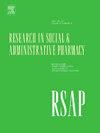面向药物问题的临床记录内容验证。
IF 3.7
3区 医学
Q1 PUBLIC, ENVIRONMENTAL & OCCUPATIONAL HEALTH
Research in Social & Administrative Pharmacy
Pub Date : 2025-01-23
DOI:10.1016/j.sapharm.2025.01.009
引用次数: 0
摘要
背景:在世界范围内,医院负责恢复健康。然而,在这些机构中,执行不当的流程可能会给患者带来风险和伤害,特别是在识别与药物有关的问题方面。这一事实证明提出工具来支持这些问题的诊断、管理和解决是合理的。目的:开发和内容验证面向药物相关问题的临床记录。方法:首先建立以药物为导向的临床记录,然后进行内容验证。该研究于2017年9月至12月进行。7.7第一版药物相关临床记录由两位经验丰富的研究人员编写,使用文献中描述的研究和问题导向的医疗工具。此后,使用名义组技术进行内容验证。专家组由一名医生、两名护士和三名在医院环境或药学护理方面具有临床经验的药剂师组成。之后,根据客观性、简洁性、清晰度和相关性标准对各自的工具进行评估。这些标准旨在确保仪器内容的严谨性和可靠性。结果:专家建议修改部分项目顺序、增加新项目、修改项目填写程序、扩大特定字段、完善作为项目填写的数据规范等。该仪器的最终版本名为“DAM临床记录”(诊断-不良临床发现-药物),包括45个项目,分为6个部分:患者识别、记忆、临床诊断、不良临床发现、药物和药物评估。结论:开发了一套以药物相关问题为导向的临床档案DAM,用于指导医护人员识别和解决药物相关问题。所有在医院环境中产生的相关信息,经过彻底的内容验证后,连续存储为面向药物问题的临床记录。本文章由计算机程序翻译,如有差异,请以英文原文为准。
Content validation of drug problem-oriented clinical record
Background
Worldwide, hospitals are responsible for restoring health. However, poorly executed processes in these institutions can lead to risks and harm to patients, especially in identifying drug related problems. This fact justifies the proposal of tools to support the diagnosis, management and resolution of these problems.
Objective
To develop and content validate a clinical record that is oriented towards drug-related problems.
Method
A drug-oriented clinical record was first developed, after which it underwent content validation. The study was carried out between September and December 2017.7 The first version of the drug-related clinical record was prepared by two experienced researchers, using studies and problem-oriented medical tools described in the literature. Thereafter, content validation was performed using the nominal group technique. The expert panel consisted of a physician, two nurses, and three pharmacists with clinical experience in a hospital setting or pharmaceutical care. After that, the respective instrument was assessed according to the criteria objectivity, simplicity, clarity, relevance. These criteria are intended to ensure the rigor and reliability of instrument content.
Results
Experts’ suggestions included modification of the order of some items, insertion of new items, modification of item-writing procedures, expansion of specific fields, and better specification of data that is to be filled in as an item. The final version of the instrument was titled “DAM Clinical Record” (Diagnostics - Adverse Clinical Findings - Medicines) and comprised 45 items categorized into six sections: Patient Identification, Anamnesis, Clinical Diagnosis, Adverse Clinical Findings, Medicines and Pharmaceutical Evaluation.
Conclusion
A clinical record oriented towards drug-related problems, named DAM, was developed to guide healthcare professionals in identifying and solving drug-related problems. All relevant information generated in the hospital setting was consecutively stored as drug problem-oriented clinical records after undergoing thorough content validation.
求助全文
通过发布文献求助,成功后即可免费获取论文全文。
去求助
来源期刊

Research in Social & Administrative Pharmacy
PUBLIC, ENVIRONMENTAL & OCCUPATIONAL HEALTH-
CiteScore
7.20
自引率
10.30%
发文量
225
审稿时长
47 days
期刊介绍:
Research in Social and Administrative Pharmacy (RSAP) is a quarterly publication featuring original scientific reports and comprehensive review articles in the social and administrative pharmaceutical sciences. Topics of interest include outcomes evaluation of products, programs, or services; pharmacoepidemiology; medication adherence; direct-to-consumer advertising of prescription medications; disease state management; health systems reform; drug marketing; medication distribution systems such as e-prescribing; web-based pharmaceutical/medical services; drug commerce and re-importation; and health professions workforce issues.
 求助内容:
求助内容: 应助结果提醒方式:
应助结果提醒方式:


